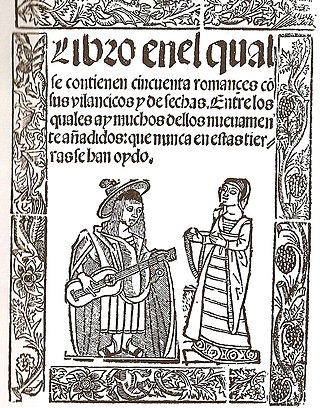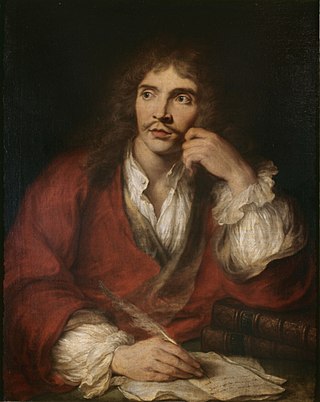
Alexandrine is a name used for several distinct types of verse line with related metrical structures, most of which are ultimately derived from the classical French alexandrine. The line's name derives from its use in the Medieval French Roman d'Alexandre of 1170, although it had already been used several decades earlier in Le Pèlerinage de Charlemagne. The foundation of most alexandrines consists of two hemistichs (half-lines) of six syllables each, separated by a caesura :
o o o o o o | o o o o o o o=any syllable; |=caesura
In poetry, a hendecasyllable is a line of eleven syllables. The term may refer to several different poetic meters, the older of which are quantitative and used chiefly in classical poetry, and the newer of which are syllabic or accentual-syllabic and used in medieval and modern poetry.
In poetry, metre or meter is the basic rhythmic structure of a verse or lines in verse. Many traditional verse forms prescribe a specific verse metre, or a certain set of metres alternating in a particular order. The study and the actual use of metres and forms of versification are both known as prosody.

Poetry is a form of literary art that uses aesthetic and often rhythmic qualities of language to evoke meanings in addition to, or in place of, literal or surface-level meanings. Any particular instance of poetry is called a poem and is written by a poet. Poets use a variety of techniques called poetic devices, such as assonance, alliteration, euphony and cacophony, onomatopoeia, rhythm, and sound symbolism, to produce musical or other artistic effects. Most written poems are formatted in verse: a series or stack of lines on a page, which follow a rhythmic or other deliberate structure. For this reason, verse has also become a synonym for poetry.
A rhyme is a repetition of similar sounds in the final stressed syllables and any following syllables of two or more words. Most often, this kind of rhyming is consciously used for a musical or aesthetic effect in the final position of lines within poems or songs. More broadly, a rhyme may also variously refer to other types of similar sounds near the ends of two or more words. Furthermore, the word rhyme has come to be sometimes used as a shorthand term for any brief poem, such as a nursery rhyme or Balliol rhyme.

A caesura, also written cæsura and cesura, is a metrical pause or break in a verse where one phrase ends and another phrase begins. It may be expressed by a comma (,), a tick (✓), or two lines, either slashed (//) or upright (||). In time value, this break may vary between the slightest perception of silence all the way up to a full pause.

In prosody, alliterative verse is a form of verse that uses alliteration as the principal device to indicate the underlying metrical structure, as opposed to other devices such as rhyme. The most commonly studied traditions of alliterative verse are those found in the oldest literature of the Germanic languages, where scholars use the term 'alliterative poetry' rather broadly to indicate a tradition which not only shares alliteration as its primary ornament but also certain metrical characteristics. The Old English epic Beowulf, as well as most other Old English poetry, the Old High German Muspilli, the Old Saxon Heliand, the Old Norse Poetic Edda, and many Middle English poems such as Piers Plowman, Sir Gawain and the Green Knight, Layamon's Brut and the Alliterative Morte Arthur all use alliterative verse.
Syllabic verse is a poetic form having a fixed or constrained number of syllables per line, while stress, quantity, or tone play a distinctly secondary role—or no role at all—in the verse structure. It is common in languages that are syllable-timed, such as French or Finnish, as opposed to stress-timed languages such as English, in which accentual verse and accentual-syllabic verse are more common.
Old Norse poetry encompasses a range of verse forms written in the Old Norse language, during the period from the 8th century to as late as the far end of the 13th century. Old Norse poetry is associated with the area now referred to as Scandinavia. Much Old Norse poetry was originally preserved in oral culture, but the Old Norse language ceased to be spoken and later writing tended to be confined to history rather than for new poetic creation, which is normal for an extinct language. Modern knowledge of Old Norse poetry is preserved by what was written down. Most of the Old Norse poetry that survives was composed or committed to writing in Iceland, after refined techniques for writing were introduced—seemingly contemporaneously with the introduction of Christianity: thus, the general topic area of Old Norse poetry may be referred to as Old Icelandic poetry in literature.
Iambic pentameter is a type of metric line used in traditional English poetry and verse drama. The term describes the rhythm, or meter, established by the words in each line. Rhythm is measured in small groups of syllables called "feet". "Iambic" indicates that the type of foot used is the iamb, which in English is an unstressed syllable followed by a stressed syllable. "Pentameter" indicates that each line has five "feet".
French poetry is a category of French literature. It may include Francophone poetry composed outside France and poetry written in other languages of France.

Heroic verse is a term that may be used to designate epic poems, but which is more usually used to describe the meter(s) in which those poems are most typically written. Because the meter typically used to narrate heroic deeds differs by language and even within language by period, the specific meaning of "heroic verse" is dependent upon context.
Decasyllable is a poetic meter of ten syllables used in poetic traditions of syllabic verse. In languages with a stress accent, it is the equivalent of pentameter with iambs or trochees.
This is a glossary of poetry terms.
The octosyllable or octosyllabic verse is a line of verse with eight syllables. It is equivalent to tetrameter verse in trochees in languages with a stress accent. Its first occurrence is in a 10th-century Old French saint's legend, the Vie de Saint Leger; another early use is in the early 12th-century Anglo-Norman Voyage de saint Brendan. It is often used in French, Italian, Spanish and Portuguese poetry. While commonly used in couplets, typical stanzas using octosyllables are: décima, some quatrains, redondilla.
A line is a unit of writing into which a poem or play is divided: literally, a single row of text. The use of a line operates on principles which are distinct from and not necessarily coincident with grammatical structures, such as the sentence or single clauses in sentences. Although the word for a single poetic line is verse, that term now tends to be used to signify poetic form more generally. A line break is the termination of the line of a poem and the beginning of a new line.

The romance is a metrical form used in Spanish poetry. It consists of an indefinite series (tirada) of verses, in which the even-numbered lines have a near-rhyme (assonance) and the odd lines are unrhymed. The lines are octosyllabic ; a similar but far less common form is hexasyllabic and is known in Spanish as romancillo ; that, or any other form of less than eight syllables may also be referred to as romance corto. A similar form in alexandrines also exists, but was traditionally used in Spanish only for learned poetry.
Polish alexandrine is a common metrical line in Polish poetry. It is similar to the French alexandrine. Each line is composed of thirteen syllables with a caesura after the seventh syllable. The main stresses are placed on the sixth and twelfth syllables. Rhymes are feminine.
1 2 3 4 5 6 7 1 2 3 4 5 6 o o o o o S x | o o o o S x Moja wdzięczna Orszulo, bodaj ty mnie była S=stressed syllable; x=unstressed syllable; o=any syllable.

The French alexandrine is a syllabic poetic metre of 12 syllables with a medial caesura dividing the line into two hemistichs (half-lines) of six syllables each. It was the dominant long line of French poetry from the 17th through the 19th century, and influenced many other European literatures which developed alexandrines of their own.
The hexasyllable or hexasyllabic verse is a line of verse with six syllables.






